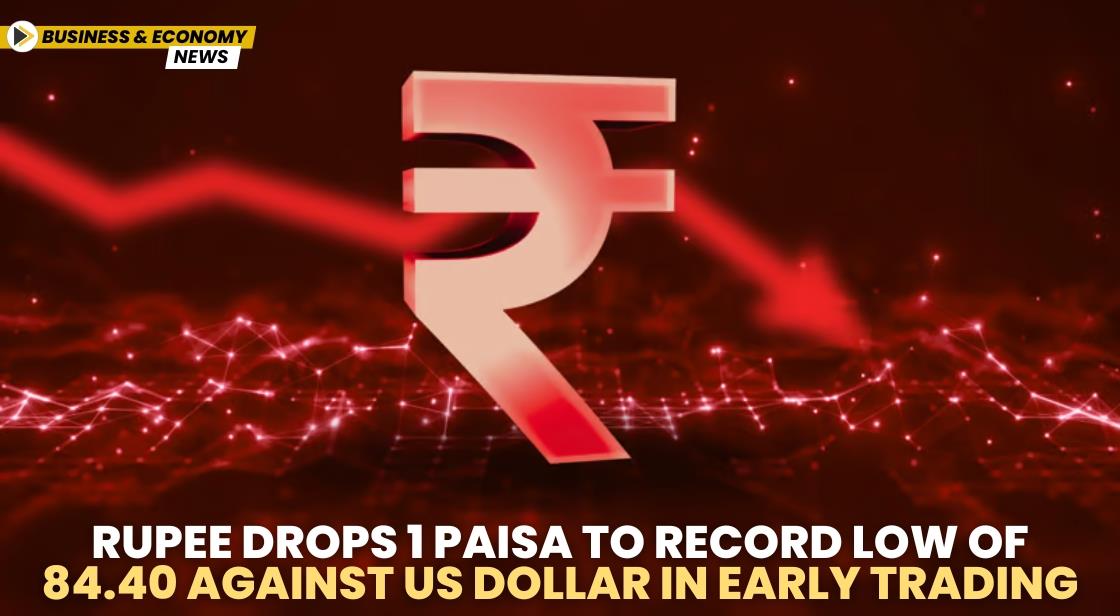Rupee Drops 1 Paisa to Record Low of 84.40 Against US Dollar in Early Trading

News Synopsis
On Wednesday morning, the Indian rupee slipped 1 paisa to a new all-time low of 84.40 against the US dollar. The downward movement in the local currency was attributed to persistent foreign fund outflows and the subdued trend in domestic equities. The USDINR pair has seen significant volatility in recent sessions, with the rupee inching closer to its record low of 84.40, largely driven by global market factors, especially the strengthening of the US Dollar Index.
Forex Market Trends and Volatility
The rupee opened at 84.40 against the US dollar in the interbank foreign exchange market, reflecting a fall of 1 paisa from its previous close. On the preceding day, Tuesday, the rupee had already touched a lifetime low of 84.39, marking a similar downward trend. Forex traders noted that the rupee's movement remains volatile, reflecting the influence of global financial factors, with the Dollar Index strengthening in international markets.
Support Levels and Reserve Bank of India (RBI) Actions
Despite the ongoing depreciation, some experts believe that the rupee has found support around the 84.50 level, with depreciation likely to remain limited. CR Forex Advisors' MD, Amit Pabari, stated that the rupee has established support around current levels, and the RBI has been playing a role in limiting further depreciation. The central bank's actions, including the sale of dollars, have been aimed at protecting the rupee from sharp declines.
In the recent weeks, India’s foreign exchange reserves have declined for the fifth consecutive week. India’s forex reserves currently stand at USD 682 billion, down from a high of USD 704 billion. This reduction in reserves is likely due to the RBI's interventions to stabilize the currency.
Dollar Index and Global Crude Price Movements
At the global level, the dollar index, which measures the strength of the US dollar against a basket of six major currencies, was trading slightly lower by 0.04%, at 105.98. Meanwhile, Brent crude, the global oil benchmark, rose by 0.25% to USD 72.07 per barrel in futures trading. The movement in global oil prices can have an indirect effect on the Indian rupee, as higher oil prices tend to increase the demand for dollars in the country due to the import of crude oil.
Domestic Equity Market Impact
On the domestic equity front, the Sensex was down by 210.66 points, or 0.27%, at 78,464.52 points, while the Nifty dropped 100.45 points, or 0.42%, to 23,783.00 points. The weakening of the rupee and the fall in the stock market were reflective of the broader economic pressures in the country.
Foreign Institutional Investor (FII) Selling
Foreign Institutional Investors (FIIs) were net sellers in the capital markets, offloading shares worth Rs 3,024.31 crore on Tuesday. This outflow of foreign funds has been a contributing factor to the rupee's decline, as the selling of shares results in more demand for foreign currency, putting further pressure on the Indian rupee.
Macroeconomic Developments
On the macroeconomic front, India’s retail inflation rose to a 14-month high of 6.21% in October, driven mainly by increasing food prices. This surge in inflation surpassed the upper tolerance limit set by the Reserve Bank of India (RBI). In comparison, the inflation rate in September was 5.49%, and in October 2023, it was lower at 4.87%.
In terms of industrial performance, India’s industrial production grew by 3.1% in September after a contraction in the previous month. All three major segments—mining, manufacturing, and power generation—showed improvements. However, the growth was lower than the 6.4% registered in September 2023, suggesting that industrial recovery remains moderate.
Conclusion
The Indian rupee’s continuous decline against the US dollar, along with the weakening stock market and rising inflation, reflects the ongoing economic challenges in India. While the RBI’s interventions have limited further depreciation, external factors like the strengthening dollar and persistent foreign outflows continue to weigh on the rupee. With the global economic environment and domestic factors both influencing the currency, the coming weeks could provide further insights into the currency’s movement and India's broader economic trajectory.
You May Like









